Analyzing Information Technology in the Business Sector: NatWest
VerifiedAdded on 2023/01/19
|10
|2911
|70
Report
AI Summary
This individual report delves into the utilization of information technology in the business environment, with a specific focus on National Westminster Bank PLC (NatWest). The report explores the application of various computing technologies, including blockchain, upgraded ATMs, and mobile banking, within the banking sector. It examines the different types of networks (LAN, MAN, WAN) and the importance of ICT, intranet, and internet in modern business operations. Furthermore, the report discusses the role of IT in management, encompassing planning, organizing, and decision-making, alongside the stages of system development. It also addresses the social and ethical issues arising from the use of technology, such as privacy concerns and the potential for misuse. The report highlights the impact of IT on business productivity, communication, customer experience, and market expansion, offering a comprehensive analysis of technology's influence on the banking sector.
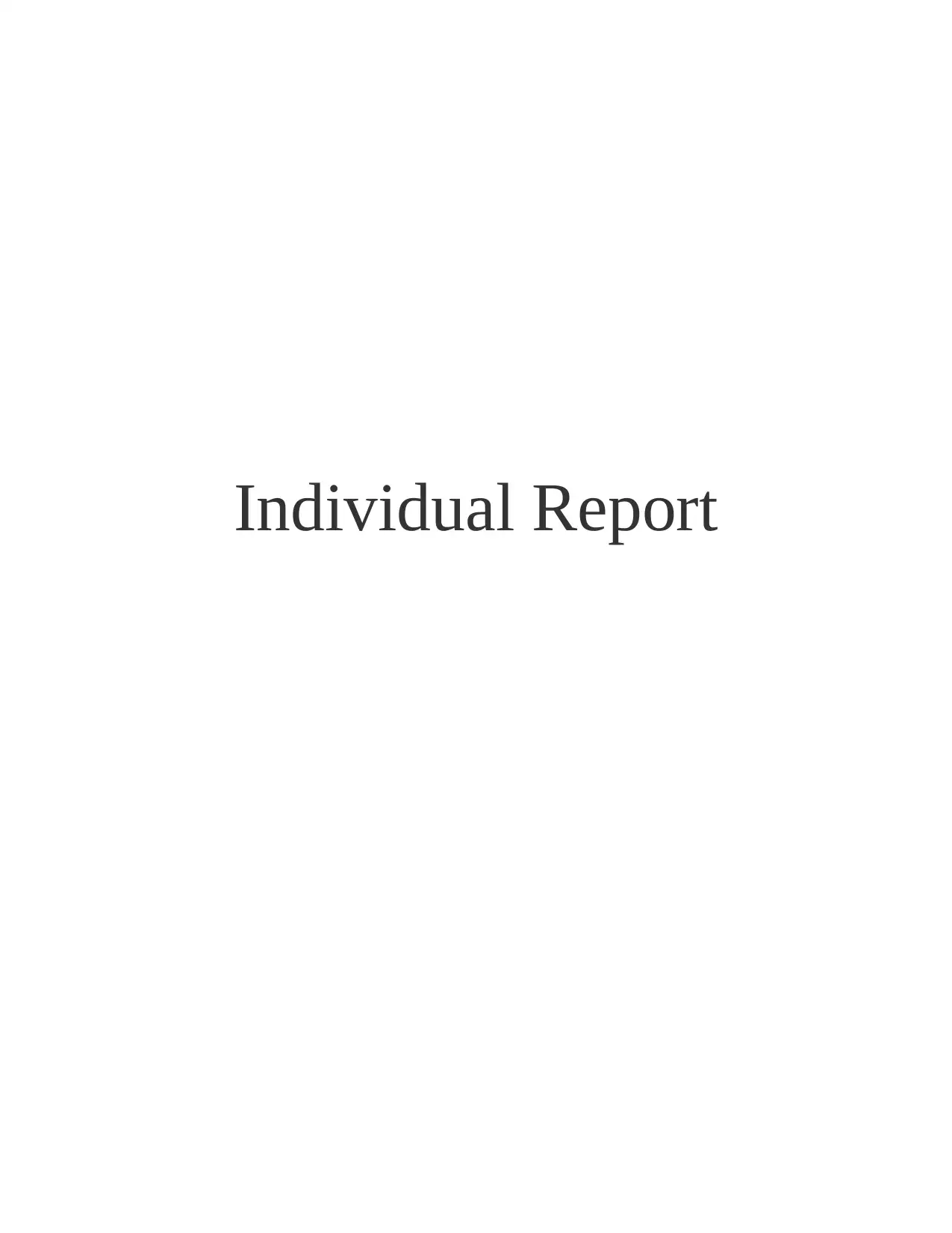
Individual Report
Paraphrase This Document
Need a fresh take? Get an instant paraphrase of this document with our AI Paraphraser
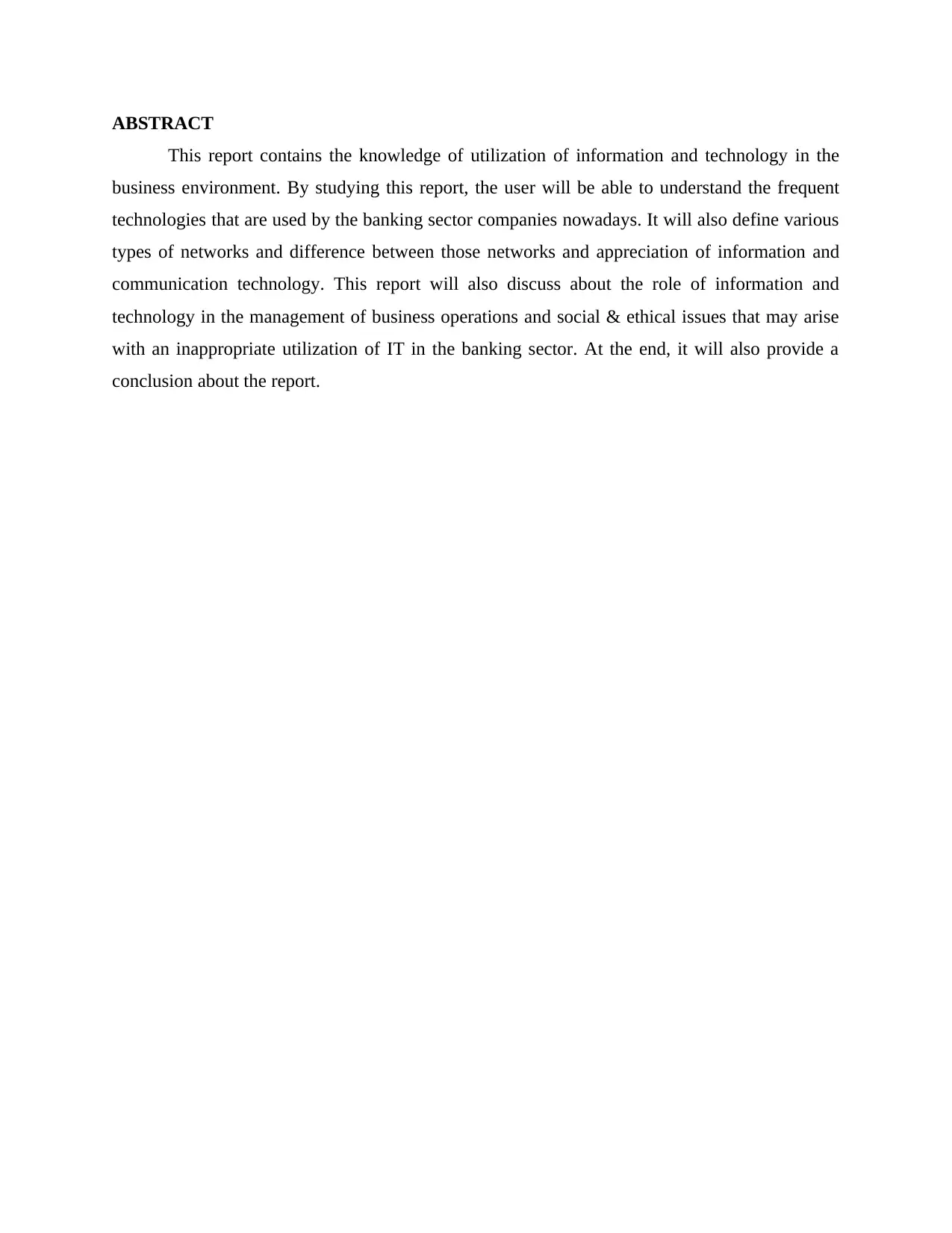
ABSTRACT
This report contains the knowledge of utilization of information and technology in the
business environment. By studying this report, the user will be able to understand the frequent
technologies that are used by the banking sector companies nowadays. It will also define various
types of networks and difference between those networks and appreciation of information and
communication technology. This report will also discuss about the role of information and
technology in the management of business operations and social & ethical issues that may arise
with an inappropriate utilization of IT in the banking sector. At the end, it will also provide a
conclusion about the report.
This report contains the knowledge of utilization of information and technology in the
business environment. By studying this report, the user will be able to understand the frequent
technologies that are used by the banking sector companies nowadays. It will also define various
types of networks and difference between those networks and appreciation of information and
communication technology. This report will also discuss about the role of information and
technology in the management of business operations and social & ethical issues that may arise
with an inappropriate utilization of IT in the banking sector. At the end, it will also provide a
conclusion about the report.
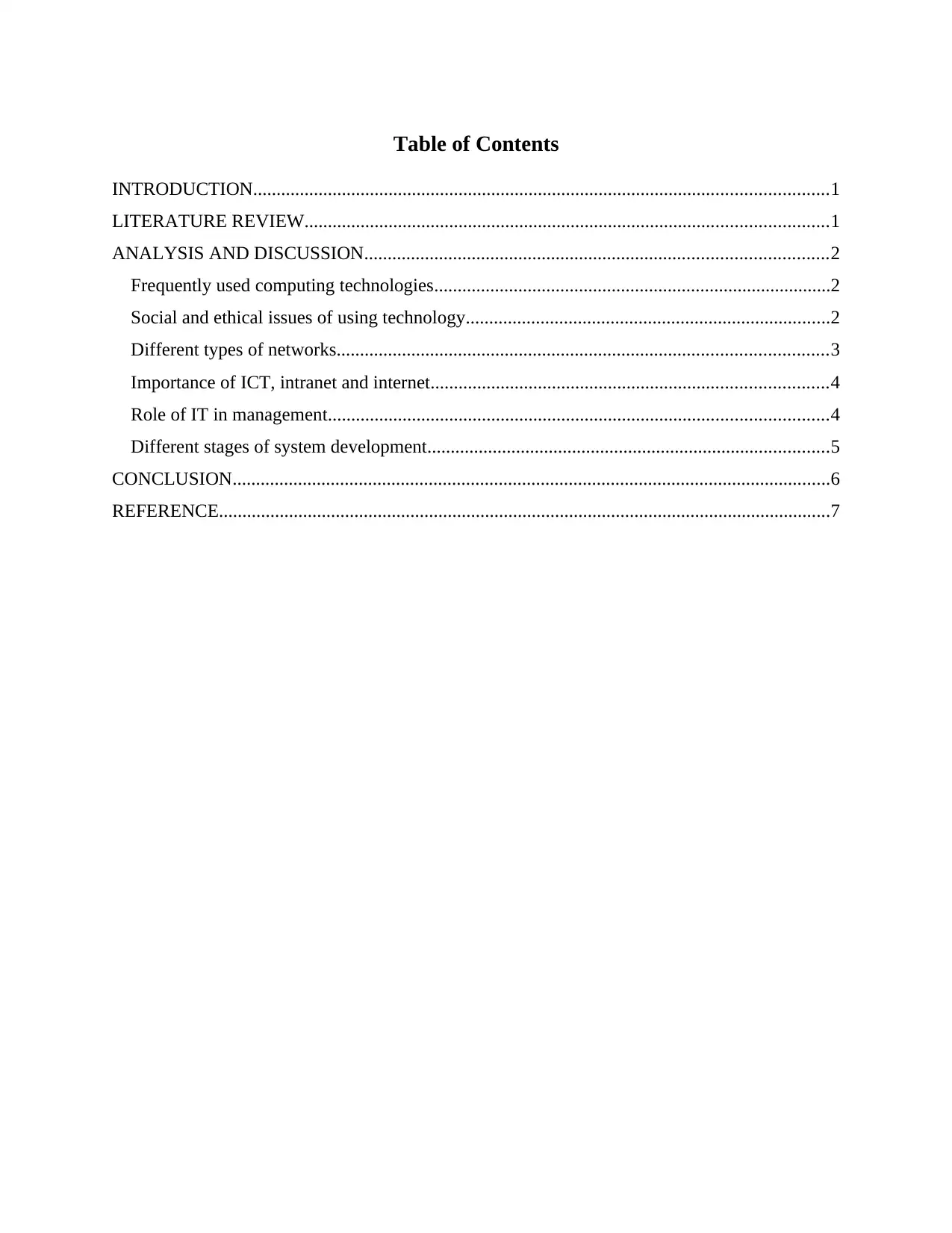
Table of Contents
INTRODUCTION...........................................................................................................................1
LITERATURE REVIEW................................................................................................................1
ANALYSIS AND DISCUSSION...................................................................................................2
Frequently used computing technologies.....................................................................................2
Social and ethical issues of using technology..............................................................................2
Different types of networks.........................................................................................................3
Importance of ICT, intranet and internet.....................................................................................4
Role of IT in management...........................................................................................................4
Different stages of system development......................................................................................5
CONCLUSION................................................................................................................................6
REFERENCE...................................................................................................................................7
INTRODUCTION...........................................................................................................................1
LITERATURE REVIEW................................................................................................................1
ANALYSIS AND DISCUSSION...................................................................................................2
Frequently used computing technologies.....................................................................................2
Social and ethical issues of using technology..............................................................................2
Different types of networks.........................................................................................................3
Importance of ICT, intranet and internet.....................................................................................4
Role of IT in management...........................................................................................................4
Different stages of system development......................................................................................5
CONCLUSION................................................................................................................................6
REFERENCE...................................................................................................................................7
⊘ This is a preview!⊘
Do you want full access?
Subscribe today to unlock all pages.

Trusted by 1+ million students worldwide
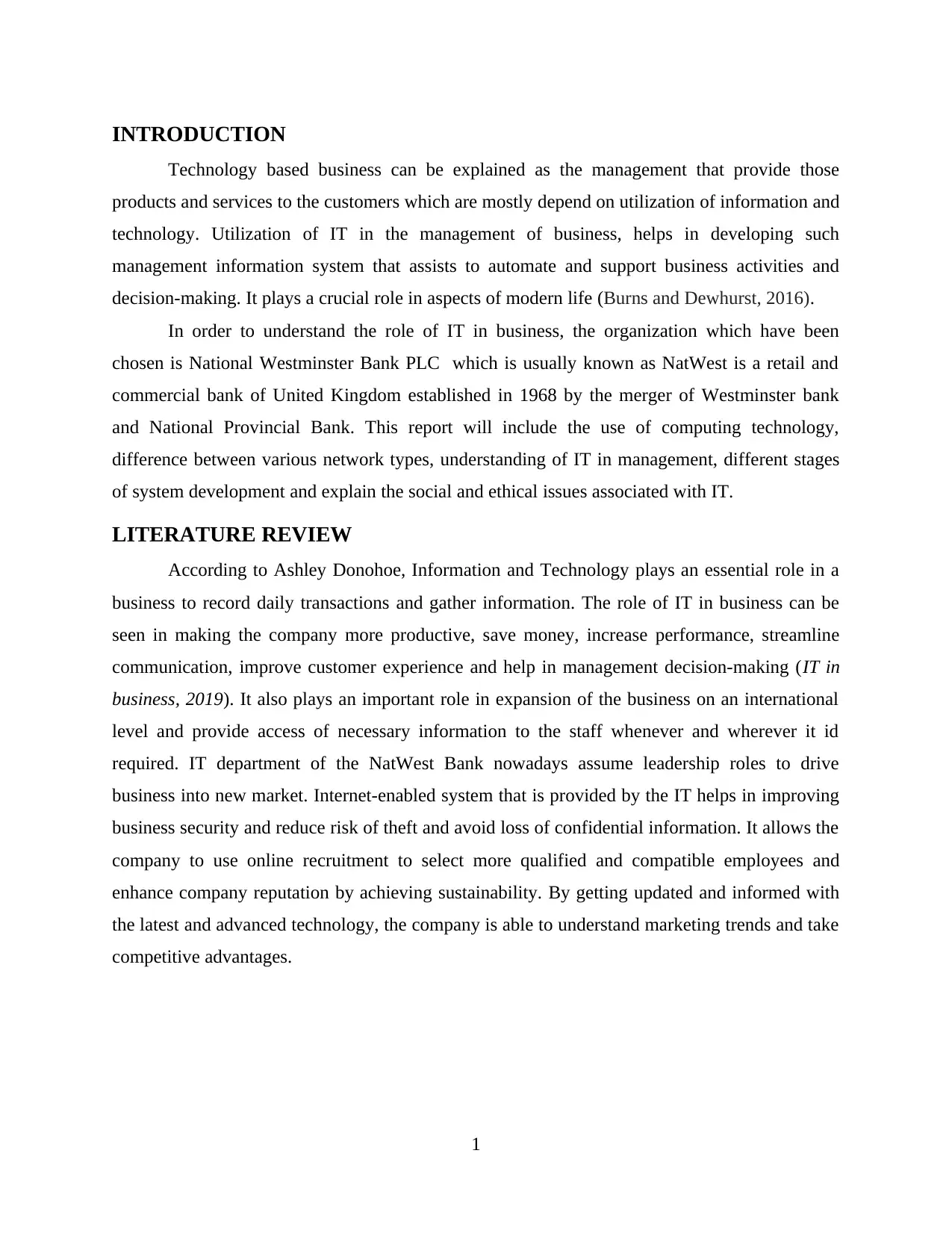
INTRODUCTION
Technology based business can be explained as the management that provide those
products and services to the customers which are mostly depend on utilization of information and
technology. Utilization of IT in the management of business, helps in developing such
management information system that assists to automate and support business activities and
decision-making. It plays a crucial role in aspects of modern life (Burns and Dewhurst, 2016).
In order to understand the role of IT in business, the organization which have been
chosen is National Westminster Bank PLC which is usually known as NatWest is a retail and
commercial bank of United Kingdom established in 1968 by the merger of Westminster bank
and National Provincial Bank. This report will include the use of computing technology,
difference between various network types, understanding of IT in management, different stages
of system development and explain the social and ethical issues associated with IT.
LITERATURE REVIEW
According to Ashley Donohoe, Information and Technology plays an essential role in a
business to record daily transactions and gather information. The role of IT in business can be
seen in making the company more productive, save money, increase performance, streamline
communication, improve customer experience and help in management decision-making (IT in
business, 2019). It also plays an important role in expansion of the business on an international
level and provide access of necessary information to the staff whenever and wherever it id
required. IT department of the NatWest Bank nowadays assume leadership roles to drive
business into new market. Internet-enabled system that is provided by the IT helps in improving
business security and reduce risk of theft and avoid loss of confidential information. It allows the
company to use online recruitment to select more qualified and compatible employees and
enhance company reputation by achieving sustainability. By getting updated and informed with
the latest and advanced technology, the company is able to understand marketing trends and take
competitive advantages.
1
Technology based business can be explained as the management that provide those
products and services to the customers which are mostly depend on utilization of information and
technology. Utilization of IT in the management of business, helps in developing such
management information system that assists to automate and support business activities and
decision-making. It plays a crucial role in aspects of modern life (Burns and Dewhurst, 2016).
In order to understand the role of IT in business, the organization which have been
chosen is National Westminster Bank PLC which is usually known as NatWest is a retail and
commercial bank of United Kingdom established in 1968 by the merger of Westminster bank
and National Provincial Bank. This report will include the use of computing technology,
difference between various network types, understanding of IT in management, different stages
of system development and explain the social and ethical issues associated with IT.
LITERATURE REVIEW
According to Ashley Donohoe, Information and Technology plays an essential role in a
business to record daily transactions and gather information. The role of IT in business can be
seen in making the company more productive, save money, increase performance, streamline
communication, improve customer experience and help in management decision-making (IT in
business, 2019). It also plays an important role in expansion of the business on an international
level and provide access of necessary information to the staff whenever and wherever it id
required. IT department of the NatWest Bank nowadays assume leadership roles to drive
business into new market. Internet-enabled system that is provided by the IT helps in improving
business security and reduce risk of theft and avoid loss of confidential information. It allows the
company to use online recruitment to select more qualified and compatible employees and
enhance company reputation by achieving sustainability. By getting updated and informed with
the latest and advanced technology, the company is able to understand marketing trends and take
competitive advantages.
1
Paraphrase This Document
Need a fresh take? Get an instant paraphrase of this document with our AI Paraphraser
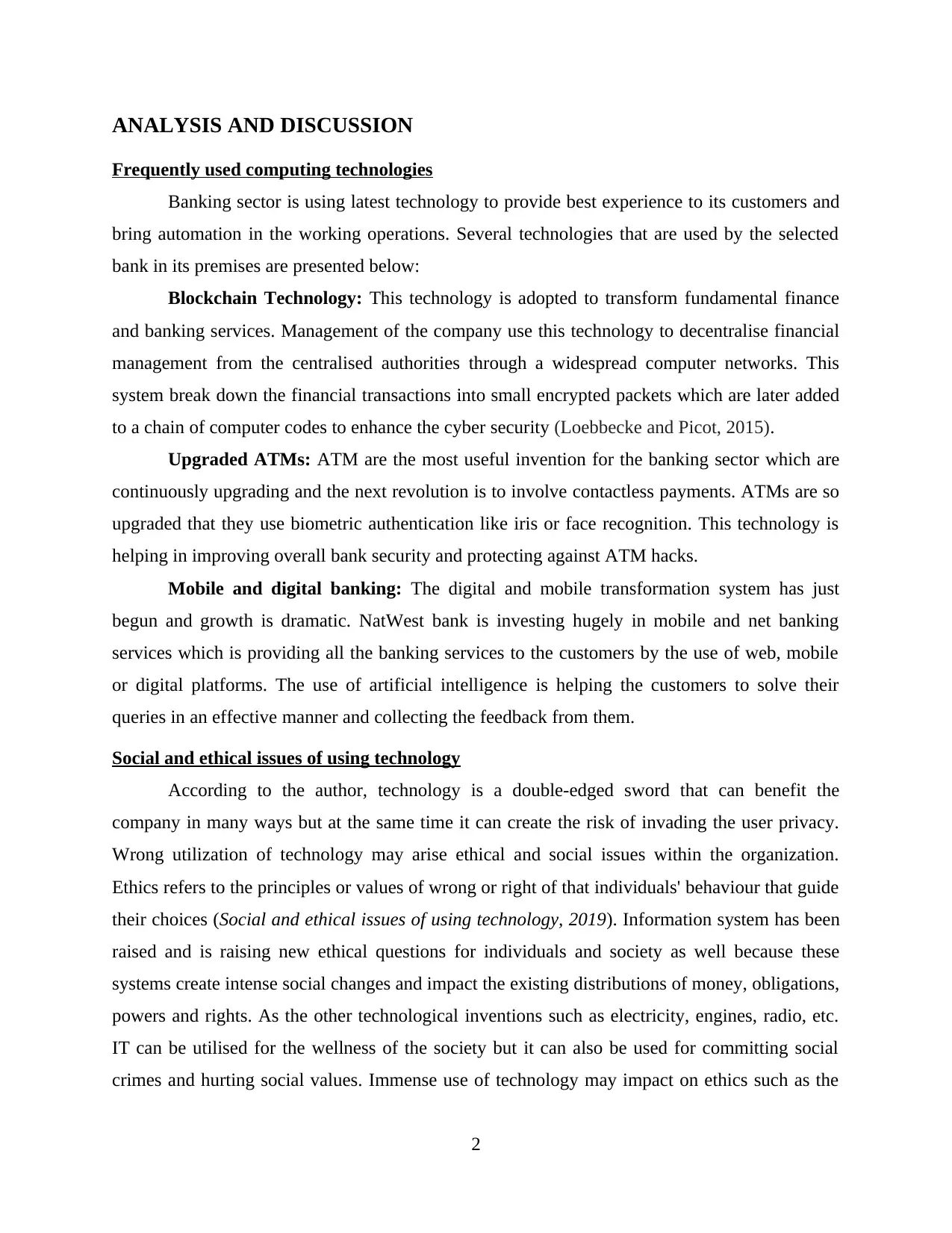
ANALYSIS AND DISCUSSION
Frequently used computing technologies
Banking sector is using latest technology to provide best experience to its customers and
bring automation in the working operations. Several technologies that are used by the selected
bank in its premises are presented below:
Blockchain Technology: This technology is adopted to transform fundamental finance
and banking services. Management of the company use this technology to decentralise financial
management from the centralised authorities through a widespread computer networks. This
system break down the financial transactions into small encrypted packets which are later added
to a chain of computer codes to enhance the cyber security (Loebbecke and Picot, 2015).
Upgraded ATMs: ATM are the most useful invention for the banking sector which are
continuously upgrading and the next revolution is to involve contactless payments. ATMs are so
upgraded that they use biometric authentication like iris or face recognition. This technology is
helping in improving overall bank security and protecting against ATM hacks.
Mobile and digital banking: The digital and mobile transformation system has just
begun and growth is dramatic. NatWest bank is investing hugely in mobile and net banking
services which is providing all the banking services to the customers by the use of web, mobile
or digital platforms. The use of artificial intelligence is helping the customers to solve their
queries in an effective manner and collecting the feedback from them.
Social and ethical issues of using technology
According to the author, technology is a double-edged sword that can benefit the
company in many ways but at the same time it can create the risk of invading the user privacy.
Wrong utilization of technology may arise ethical and social issues within the organization.
Ethics refers to the principles or values of wrong or right of that individuals' behaviour that guide
their choices (Social and ethical issues of using technology, 2019). Information system has been
raised and is raising new ethical questions for individuals and society as well because these
systems create intense social changes and impact the existing distributions of money, obligations,
powers and rights. As the other technological inventions such as electricity, engines, radio, etc.
IT can be utilised for the wellness of the society but it can also be used for committing social
crimes and hurting social values. Immense use of technology may impact on ethics such as the
2
Frequently used computing technologies
Banking sector is using latest technology to provide best experience to its customers and
bring automation in the working operations. Several technologies that are used by the selected
bank in its premises are presented below:
Blockchain Technology: This technology is adopted to transform fundamental finance
and banking services. Management of the company use this technology to decentralise financial
management from the centralised authorities through a widespread computer networks. This
system break down the financial transactions into small encrypted packets which are later added
to a chain of computer codes to enhance the cyber security (Loebbecke and Picot, 2015).
Upgraded ATMs: ATM are the most useful invention for the banking sector which are
continuously upgrading and the next revolution is to involve contactless payments. ATMs are so
upgraded that they use biometric authentication like iris or face recognition. This technology is
helping in improving overall bank security and protecting against ATM hacks.
Mobile and digital banking: The digital and mobile transformation system has just
begun and growth is dramatic. NatWest bank is investing hugely in mobile and net banking
services which is providing all the banking services to the customers by the use of web, mobile
or digital platforms. The use of artificial intelligence is helping the customers to solve their
queries in an effective manner and collecting the feedback from them.
Social and ethical issues of using technology
According to the author, technology is a double-edged sword that can benefit the
company in many ways but at the same time it can create the risk of invading the user privacy.
Wrong utilization of technology may arise ethical and social issues within the organization.
Ethics refers to the principles or values of wrong or right of that individuals' behaviour that guide
their choices (Social and ethical issues of using technology, 2019). Information system has been
raised and is raising new ethical questions for individuals and society as well because these
systems create intense social changes and impact the existing distributions of money, obligations,
powers and rights. As the other technological inventions such as electricity, engines, radio, etc.
IT can be utilised for the wellness of the society but it can also be used for committing social
crimes and hurting social values. Immense use of technology may impact on ethics such as the
2
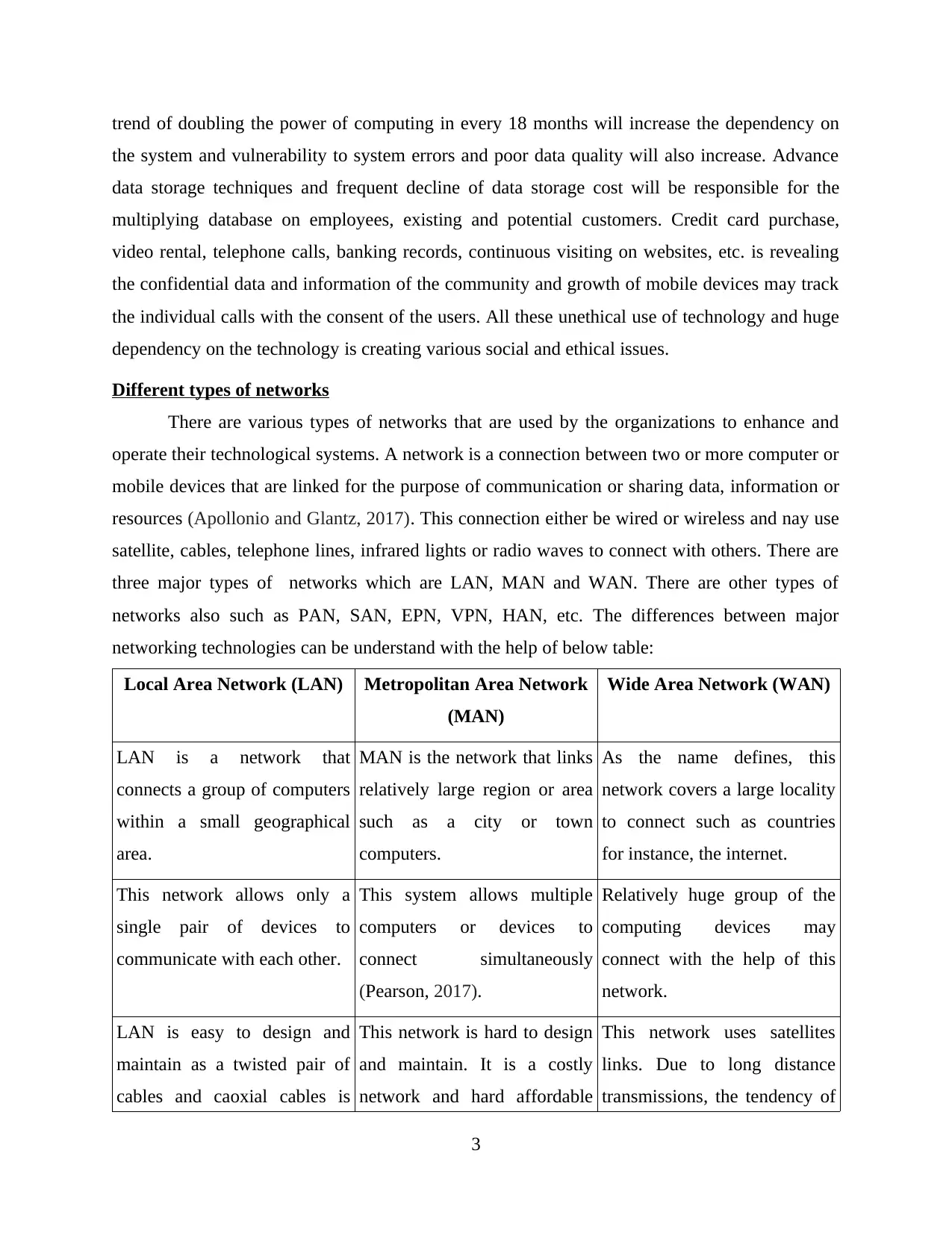
trend of doubling the power of computing in every 18 months will increase the dependency on
the system and vulnerability to system errors and poor data quality will also increase. Advance
data storage techniques and frequent decline of data storage cost will be responsible for the
multiplying database on employees, existing and potential customers. Credit card purchase,
video rental, telephone calls, banking records, continuous visiting on websites, etc. is revealing
the confidential data and information of the community and growth of mobile devices may track
the individual calls with the consent of the users. All these unethical use of technology and huge
dependency on the technology is creating various social and ethical issues.
Different types of networks
There are various types of networks that are used by the organizations to enhance and
operate their technological systems. A network is a connection between two or more computer or
mobile devices that are linked for the purpose of communication or sharing data, information or
resources (Apollonio and Glantz, 2017). This connection either be wired or wireless and nay use
satellite, cables, telephone lines, infrared lights or radio waves to connect with others. There are
three major types of networks which are LAN, MAN and WAN. There are other types of
networks also such as PAN, SAN, EPN, VPN, HAN, etc. The differences between major
networking technologies can be understand with the help of below table:
Local Area Network (LAN) Metropolitan Area Network
(MAN)
Wide Area Network (WAN)
LAN is a network that
connects a group of computers
within a small geographical
area.
MAN is the network that links
relatively large region or area
such as a city or town
computers.
As the name defines, this
network covers a large locality
to connect such as countries
for instance, the internet.
This network allows only a
single pair of devices to
communicate with each other.
This system allows multiple
computers or devices to
connect simultaneously
(Pearson, 2017).
Relatively huge group of the
computing devices may
connect with the help of this
network.
LAN is easy to design and
maintain as a twisted pair of
cables and caoxial cables is
This network is hard to design
and maintain. It is a costly
network and hard affordable
This network uses satellites
links. Due to long distance
transmissions, the tendency of
3
the system and vulnerability to system errors and poor data quality will also increase. Advance
data storage techniques and frequent decline of data storage cost will be responsible for the
multiplying database on employees, existing and potential customers. Credit card purchase,
video rental, telephone calls, banking records, continuous visiting on websites, etc. is revealing
the confidential data and information of the community and growth of mobile devices may track
the individual calls with the consent of the users. All these unethical use of technology and huge
dependency on the technology is creating various social and ethical issues.
Different types of networks
There are various types of networks that are used by the organizations to enhance and
operate their technological systems. A network is a connection between two or more computer or
mobile devices that are linked for the purpose of communication or sharing data, information or
resources (Apollonio and Glantz, 2017). This connection either be wired or wireless and nay use
satellite, cables, telephone lines, infrared lights or radio waves to connect with others. There are
three major types of networks which are LAN, MAN and WAN. There are other types of
networks also such as PAN, SAN, EPN, VPN, HAN, etc. The differences between major
networking technologies can be understand with the help of below table:
Local Area Network (LAN) Metropolitan Area Network
(MAN)
Wide Area Network (WAN)
LAN is a network that
connects a group of computers
within a small geographical
area.
MAN is the network that links
relatively large region or area
such as a city or town
computers.
As the name defines, this
network covers a large locality
to connect such as countries
for instance, the internet.
This network allows only a
single pair of devices to
communicate with each other.
This system allows multiple
computers or devices to
connect simultaneously
(Pearson, 2017).
Relatively huge group of the
computing devices may
connect with the help of this
network.
LAN is easy to design and
maintain as a twisted pair of
cables and caoxial cables is
This network is hard to design
and maintain. It is a costly
network and hard affordable
This network uses satellites
links. Due to long distance
transmissions, the tendency of
3
⊘ This is a preview!⊘
Do you want full access?
Subscribe today to unlock all pages.

Trusted by 1+ million students worldwide
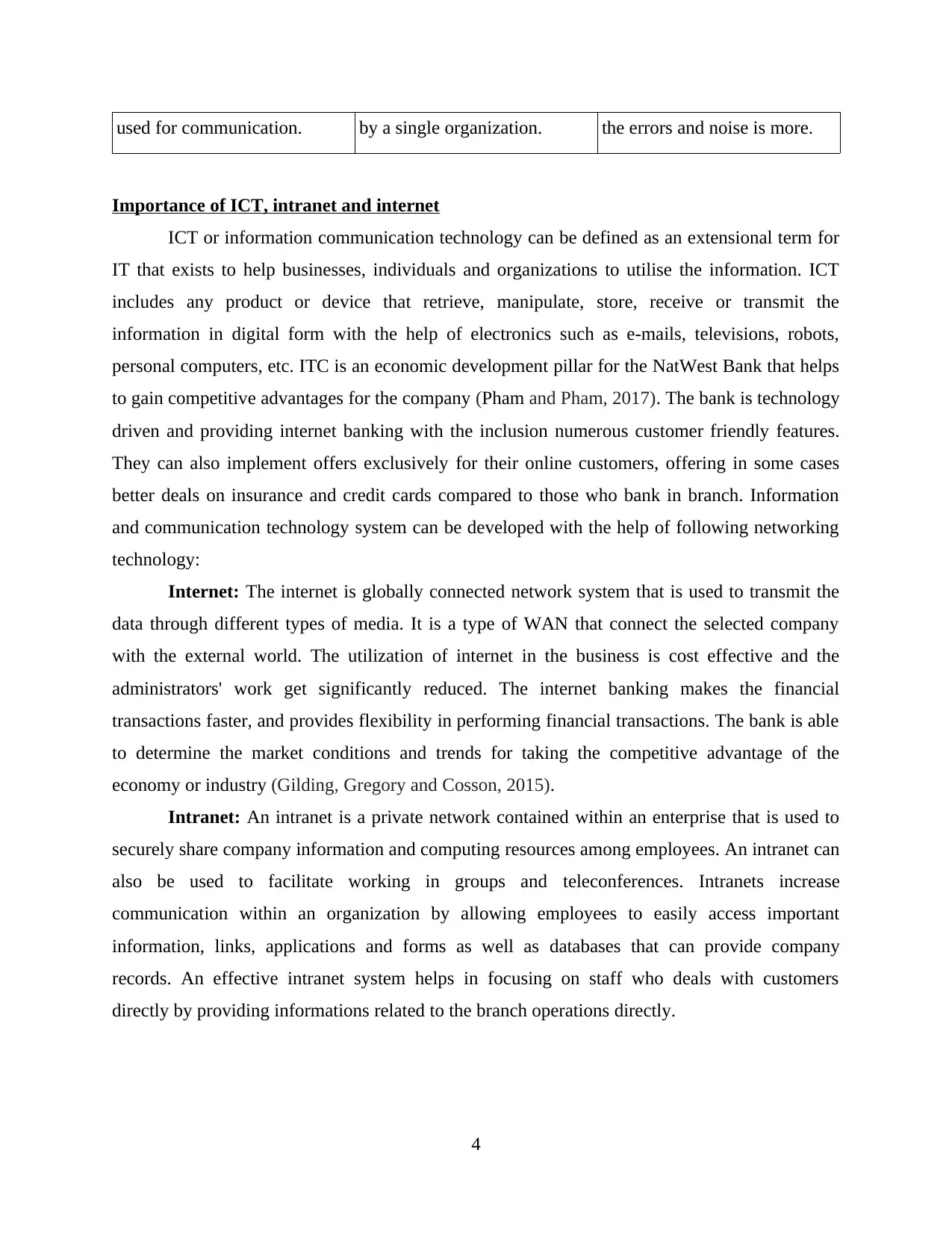
used for communication. by a single organization. the errors and noise is more.
Importance of ICT, intranet and internet
ICT or information communication technology can be defined as an extensional term for
IT that exists to help businesses, individuals and organizations to utilise the information. ICT
includes any product or device that retrieve, manipulate, store, receive or transmit the
information in digital form with the help of electronics such as e-mails, televisions, robots,
personal computers, etc. ITC is an economic development pillar for the NatWest Bank that helps
to gain competitive advantages for the company (Pham and Pham, 2017). The bank is technology
driven and providing internet banking with the inclusion numerous customer friendly features.
They can also implement offers exclusively for their online customers, offering in some cases
better deals on insurance and credit cards compared to those who bank in branch. Information
and communication technology system can be developed with the help of following networking
technology:
Internet: The internet is globally connected network system that is used to transmit the
data through different types of media. It is a type of WAN that connect the selected company
with the external world. The utilization of internet in the business is cost effective and the
administrators' work get significantly reduced. The internet banking makes the financial
transactions faster, and provides flexibility in performing financial transactions. The bank is able
to determine the market conditions and trends for taking the competitive advantage of the
economy or industry (Gilding, Gregory and Cosson, 2015).
Intranet: An intranet is a private network contained within an enterprise that is used to
securely share company information and computing resources among employees. An intranet can
also be used to facilitate working in groups and teleconferences. Intranets increase
communication within an organization by allowing employees to easily access important
information, links, applications and forms as well as databases that can provide company
records. An effective intranet system helps in focusing on staff who deals with customers
directly by providing informations related to the branch operations directly.
4
Importance of ICT, intranet and internet
ICT or information communication technology can be defined as an extensional term for
IT that exists to help businesses, individuals and organizations to utilise the information. ICT
includes any product or device that retrieve, manipulate, store, receive or transmit the
information in digital form with the help of electronics such as e-mails, televisions, robots,
personal computers, etc. ITC is an economic development pillar for the NatWest Bank that helps
to gain competitive advantages for the company (Pham and Pham, 2017). The bank is technology
driven and providing internet banking with the inclusion numerous customer friendly features.
They can also implement offers exclusively for their online customers, offering in some cases
better deals on insurance and credit cards compared to those who bank in branch. Information
and communication technology system can be developed with the help of following networking
technology:
Internet: The internet is globally connected network system that is used to transmit the
data through different types of media. It is a type of WAN that connect the selected company
with the external world. The utilization of internet in the business is cost effective and the
administrators' work get significantly reduced. The internet banking makes the financial
transactions faster, and provides flexibility in performing financial transactions. The bank is able
to determine the market conditions and trends for taking the competitive advantage of the
economy or industry (Gilding, Gregory and Cosson, 2015).
Intranet: An intranet is a private network contained within an enterprise that is used to
securely share company information and computing resources among employees. An intranet can
also be used to facilitate working in groups and teleconferences. Intranets increase
communication within an organization by allowing employees to easily access important
information, links, applications and forms as well as databases that can provide company
records. An effective intranet system helps in focusing on staff who deals with customers
directly by providing informations related to the branch operations directly.
4
Paraphrase This Document
Need a fresh take? Get an instant paraphrase of this document with our AI Paraphraser
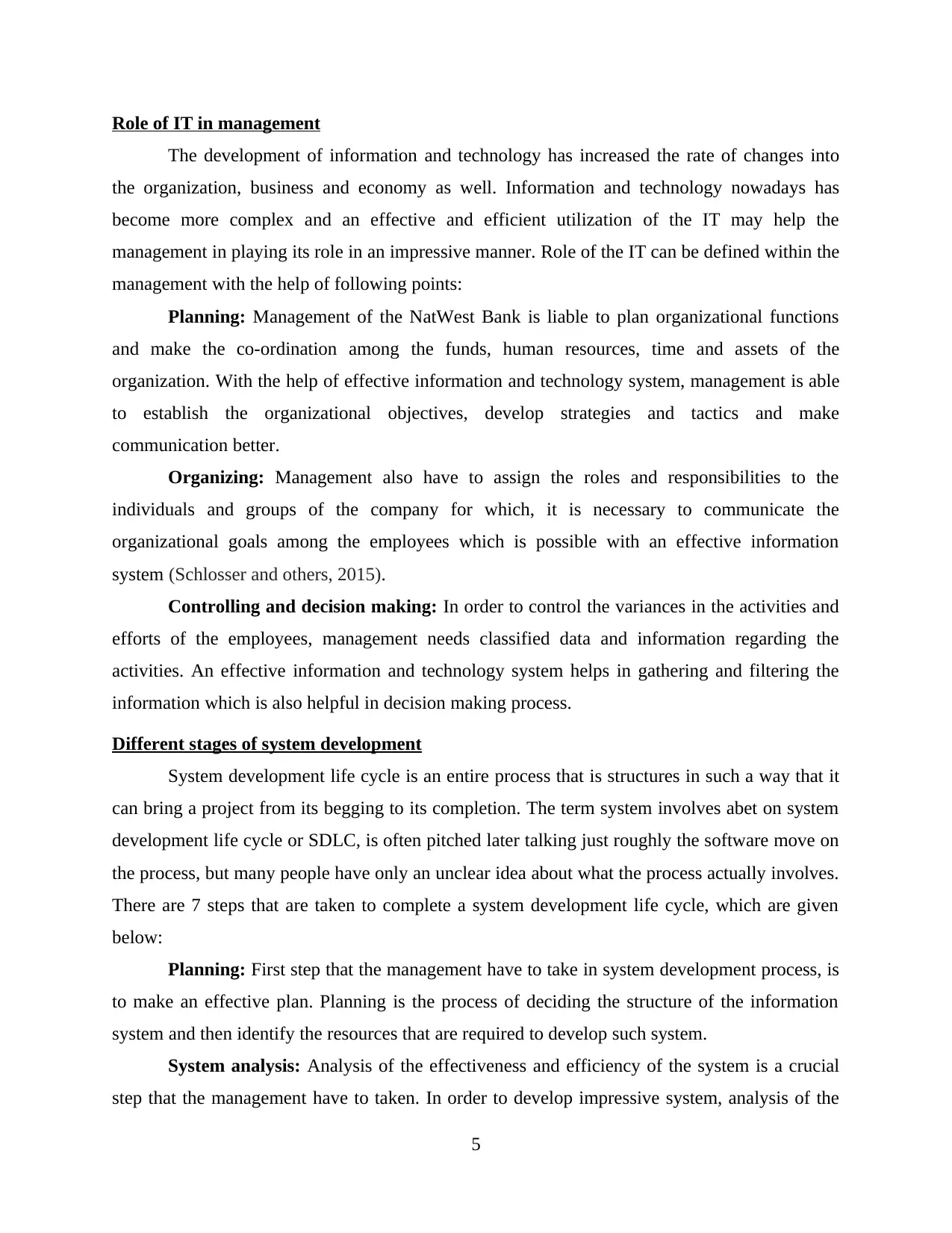
Role of IT in management
The development of information and technology has increased the rate of changes into
the organization, business and economy as well. Information and technology nowadays has
become more complex and an effective and efficient utilization of the IT may help the
management in playing its role in an impressive manner. Role of the IT can be defined within the
management with the help of following points:
Planning: Management of the NatWest Bank is liable to plan organizational functions
and make the co-ordination among the funds, human resources, time and assets of the
organization. With the help of effective information and technology system, management is able
to establish the organizational objectives, develop strategies and tactics and make
communication better.
Organizing: Management also have to assign the roles and responsibilities to the
individuals and groups of the company for which, it is necessary to communicate the
organizational goals among the employees which is possible with an effective information
system (Schlosser and others, 2015).
Controlling and decision making: In order to control the variances in the activities and
efforts of the employees, management needs classified data and information regarding the
activities. An effective information and technology system helps in gathering and filtering the
information which is also helpful in decision making process.
Different stages of system development
System development life cycle is an entire process that is structures in such a way that it
can bring a project from its begging to its completion. The term system involves abet on system
development life cycle or SDLC, is often pitched later talking just roughly the software move on
the process, but many people have only an unclear idea about what the process actually involves.
There are 7 steps that are taken to complete a system development life cycle, which are given
below:
Planning: First step that the management have to take in system development process, is
to make an effective plan. Planning is the process of deciding the structure of the information
system and then identify the resources that are required to develop such system.
System analysis: Analysis of the effectiveness and efficiency of the system is a crucial
step that the management have to taken. In order to develop impressive system, analysis of the
5
The development of information and technology has increased the rate of changes into
the organization, business and economy as well. Information and technology nowadays has
become more complex and an effective and efficient utilization of the IT may help the
management in playing its role in an impressive manner. Role of the IT can be defined within the
management with the help of following points:
Planning: Management of the NatWest Bank is liable to plan organizational functions
and make the co-ordination among the funds, human resources, time and assets of the
organization. With the help of effective information and technology system, management is able
to establish the organizational objectives, develop strategies and tactics and make
communication better.
Organizing: Management also have to assign the roles and responsibilities to the
individuals and groups of the company for which, it is necessary to communicate the
organizational goals among the employees which is possible with an effective information
system (Schlosser and others, 2015).
Controlling and decision making: In order to control the variances in the activities and
efforts of the employees, management needs classified data and information regarding the
activities. An effective information and technology system helps in gathering and filtering the
information which is also helpful in decision making process.
Different stages of system development
System development life cycle is an entire process that is structures in such a way that it
can bring a project from its begging to its completion. The term system involves abet on system
development life cycle or SDLC, is often pitched later talking just roughly the software move on
the process, but many people have only an unclear idea about what the process actually involves.
There are 7 steps that are taken to complete a system development life cycle, which are given
below:
Planning: First step that the management have to take in system development process, is
to make an effective plan. Planning is the process of deciding the structure of the information
system and then identify the resources that are required to develop such system.
System analysis: Analysis of the effectiveness and efficiency of the system is a crucial
step that the management have to taken. In order to develop impressive system, analysis of the
5
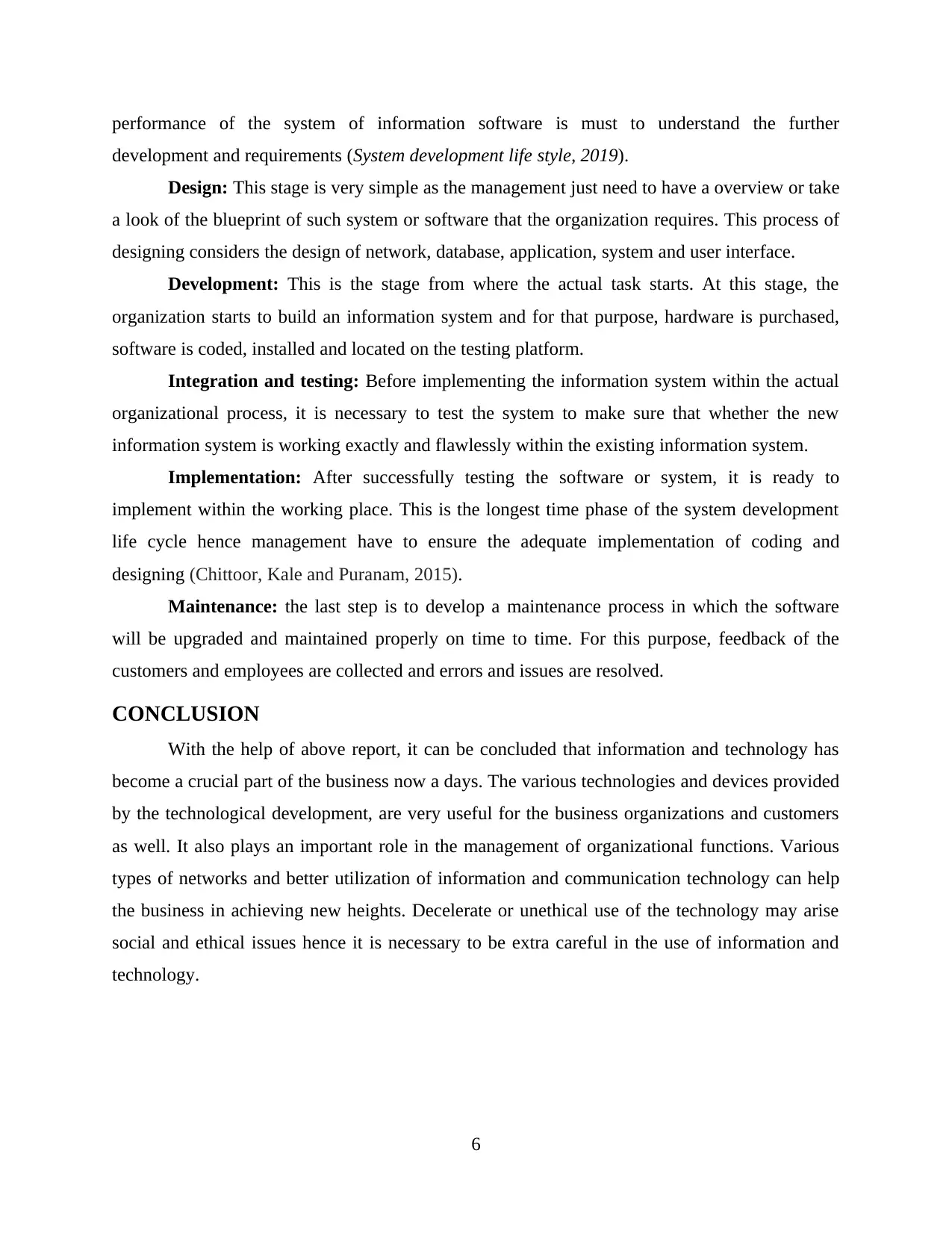
performance of the system of information software is must to understand the further
development and requirements (System development life style, 2019).
Design: This stage is very simple as the management just need to have a overview or take
a look of the blueprint of such system or software that the organization requires. This process of
designing considers the design of network, database, application, system and user interface.
Development: This is the stage from where the actual task starts. At this stage, the
organization starts to build an information system and for that purpose, hardware is purchased,
software is coded, installed and located on the testing platform.
Integration and testing: Before implementing the information system within the actual
organizational process, it is necessary to test the system to make sure that whether the new
information system is working exactly and flawlessly within the existing information system.
Implementation: After successfully testing the software or system, it is ready to
implement within the working place. This is the longest time phase of the system development
life cycle hence management have to ensure the adequate implementation of coding and
designing (Chittoor, Kale and Puranam, 2015).
Maintenance: the last step is to develop a maintenance process in which the software
will be upgraded and maintained properly on time to time. For this purpose, feedback of the
customers and employees are collected and errors and issues are resolved.
CONCLUSION
With the help of above report, it can be concluded that information and technology has
become a crucial part of the business now a days. The various technologies and devices provided
by the technological development, are very useful for the business organizations and customers
as well. It also plays an important role in the management of organizational functions. Various
types of networks and better utilization of information and communication technology can help
the business in achieving new heights. Decelerate or unethical use of the technology may arise
social and ethical issues hence it is necessary to be extra careful in the use of information and
technology.
6
development and requirements (System development life style, 2019).
Design: This stage is very simple as the management just need to have a overview or take
a look of the blueprint of such system or software that the organization requires. This process of
designing considers the design of network, database, application, system and user interface.
Development: This is the stage from where the actual task starts. At this stage, the
organization starts to build an information system and for that purpose, hardware is purchased,
software is coded, installed and located on the testing platform.
Integration and testing: Before implementing the information system within the actual
organizational process, it is necessary to test the system to make sure that whether the new
information system is working exactly and flawlessly within the existing information system.
Implementation: After successfully testing the software or system, it is ready to
implement within the working place. This is the longest time phase of the system development
life cycle hence management have to ensure the adequate implementation of coding and
designing (Chittoor, Kale and Puranam, 2015).
Maintenance: the last step is to develop a maintenance process in which the software
will be upgraded and maintained properly on time to time. For this purpose, feedback of the
customers and employees are collected and errors and issues are resolved.
CONCLUSION
With the help of above report, it can be concluded that information and technology has
become a crucial part of the business now a days. The various technologies and devices provided
by the technological development, are very useful for the business organizations and customers
as well. It also plays an important role in the management of organizational functions. Various
types of networks and better utilization of information and communication technology can help
the business in achieving new heights. Decelerate or unethical use of the technology may arise
social and ethical issues hence it is necessary to be extra careful in the use of information and
technology.
6
⊘ This is a preview!⊘
Do you want full access?
Subscribe today to unlock all pages.

Trusted by 1+ million students worldwide
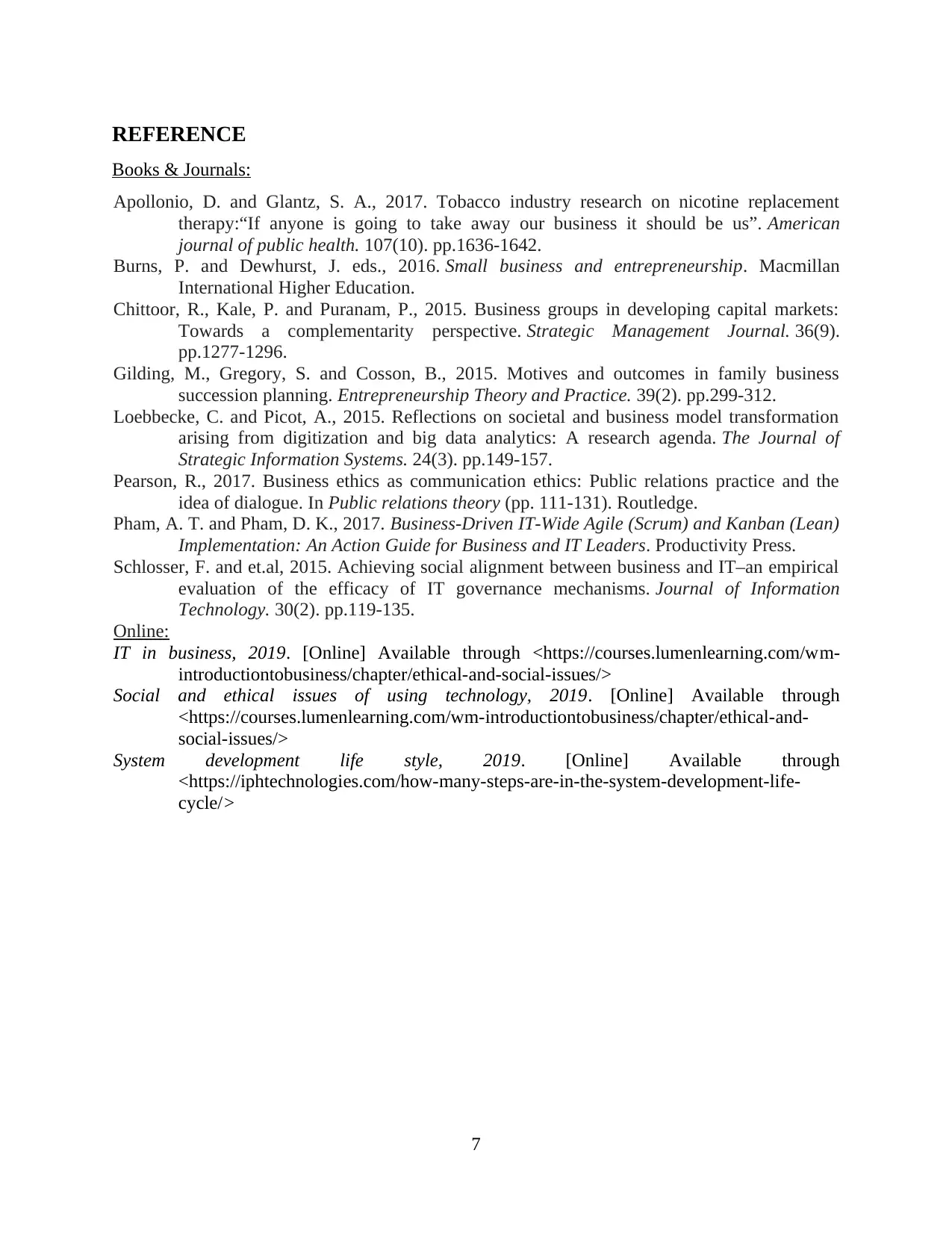
REFERENCE
Books & Journals:
Apollonio, D. and Glantz, S. A., 2017. Tobacco industry research on nicotine replacement
therapy:“If anyone is going to take away our business it should be us”. American
journal of public health. 107(10). pp.1636-1642.
Burns, P. and Dewhurst, J. eds., 2016. Small business and entrepreneurship. Macmillan
International Higher Education.
Chittoor, R., Kale, P. and Puranam, P., 2015. Business groups in developing capital markets:
Towards a complementarity perspective. Strategic Management Journal. 36(9).
pp.1277-1296.
Gilding, M., Gregory, S. and Cosson, B., 2015. Motives and outcomes in family business
succession planning. Entrepreneurship Theory and Practice. 39(2). pp.299-312.
Loebbecke, C. and Picot, A., 2015. Reflections on societal and business model transformation
arising from digitization and big data analytics: A research agenda. The Journal of
Strategic Information Systems. 24(3). pp.149-157.
Pearson, R., 2017. Business ethics as communication ethics: Public relations practice and the
idea of dialogue. In Public relations theory (pp. 111-131). Routledge.
Pham, A. T. and Pham, D. K., 2017. Business-Driven IT-Wide Agile (Scrum) and Kanban (Lean)
Implementation: An Action Guide for Business and IT Leaders. Productivity Press.
Schlosser, F. and et.al, 2015. Achieving social alignment between business and IT–an empirical
evaluation of the efficacy of IT governance mechanisms. Journal of Information
Technology. 30(2). pp.119-135.
Online:
IT in business, 2019. [Online] Available through <https://courses.lumenlearning.com/wm-
introductiontobusiness/chapter/ethical-and-social-issues/>
Social and ethical issues of using technology, 2019. [Online] Available through
<https://courses.lumenlearning.com/wm-introductiontobusiness/chapter/ethical-and-
social-issues/>
System development life style, 2019. [Online] Available through
<https://iphtechnologies.com/how-many-steps-are-in-the-system-development-life-
cycle/>
7
Books & Journals:
Apollonio, D. and Glantz, S. A., 2017. Tobacco industry research on nicotine replacement
therapy:“If anyone is going to take away our business it should be us”. American
journal of public health. 107(10). pp.1636-1642.
Burns, P. and Dewhurst, J. eds., 2016. Small business and entrepreneurship. Macmillan
International Higher Education.
Chittoor, R., Kale, P. and Puranam, P., 2015. Business groups in developing capital markets:
Towards a complementarity perspective. Strategic Management Journal. 36(9).
pp.1277-1296.
Gilding, M., Gregory, S. and Cosson, B., 2015. Motives and outcomes in family business
succession planning. Entrepreneurship Theory and Practice. 39(2). pp.299-312.
Loebbecke, C. and Picot, A., 2015. Reflections on societal and business model transformation
arising from digitization and big data analytics: A research agenda. The Journal of
Strategic Information Systems. 24(3). pp.149-157.
Pearson, R., 2017. Business ethics as communication ethics: Public relations practice and the
idea of dialogue. In Public relations theory (pp. 111-131). Routledge.
Pham, A. T. and Pham, D. K., 2017. Business-Driven IT-Wide Agile (Scrum) and Kanban (Lean)
Implementation: An Action Guide for Business and IT Leaders. Productivity Press.
Schlosser, F. and et.al, 2015. Achieving social alignment between business and IT–an empirical
evaluation of the efficacy of IT governance mechanisms. Journal of Information
Technology. 30(2). pp.119-135.
Online:
IT in business, 2019. [Online] Available through <https://courses.lumenlearning.com/wm-
introductiontobusiness/chapter/ethical-and-social-issues/>
Social and ethical issues of using technology, 2019. [Online] Available through
<https://courses.lumenlearning.com/wm-introductiontobusiness/chapter/ethical-and-
social-issues/>
System development life style, 2019. [Online] Available through
<https://iphtechnologies.com/how-many-steps-are-in-the-system-development-life-
cycle/>
7
1 out of 10
Related Documents
Your All-in-One AI-Powered Toolkit for Academic Success.
+13062052269
info@desklib.com
Available 24*7 on WhatsApp / Email
![[object Object]](/_next/static/media/star-bottom.7253800d.svg)
Unlock your academic potential
Copyright © 2020–2025 A2Z Services. All Rights Reserved. Developed and managed by ZUCOL.




